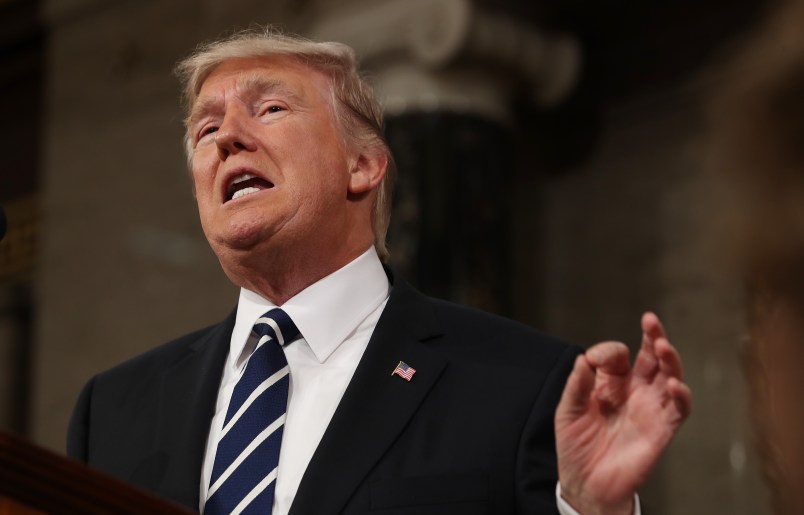A memo written by the staff of House Intel Chairman Devin Nunes (R-CA) accuses the Justice Department of a “troubling breakdown” in the process it used to secure a warrant to surveil a former Trump campaign advisor. But the memo omits sourcing for many of the claims it makes, casting doubt on some of its key assertions.
The memo was released Friday afternoon after being declassified by President Trump.
Democrats have argued that the GOP cherry-picked information from classified documents the Justice Department turned over to the committee. The FBI has also said the memo was misleading and inaccurate, making Trump’s decision to release it a major confrontation with his own agency.
As had been reported before its release, the memo focuses on a warrant, known as a FISA warrant, that the Justice Department sought in order to surveil former Trump foreign policy advisor Carter Page, after he left the campaign in the fall of 2016. It links the warrant to the dossier put together by ex-British spy Christopher Steele, as part of an oppo-research project into Trump funded at the time by the DNC and the Clinton campaign.
Until recently, Trump allies had played down Page’s involvement in the campaign, and the warrant in question was only obtained in late October 2016, well after Page had formally departed the campaign.
Trump has privately told his associates that he saw the memo as a way to discredit the current federal probe into his campaign’s Russia ties, and perhaps as a way to make it easier to fire Deputy Attorney General Rod Rosenstein. He is among the top DOJ officials referenced in the memo’s claims of misconduct.
Asked by reporters just before the memo was published if it made it more likely that Trump would fire Rosenstein, Trump said “you figure that one out.”
Firing Rosenstein would be deeply controversial because he oversees Special Counsel Robert Mueller’s probe into Russian interference in the 2016 election.
The memo claims Andrew McCabe — a top FBI official who recently bumped up his retirement date under intense scrutiny led by Trump – testified to the committee in December that the Page warrant would not have been sought without the Steele information. Since the memo’s release, Democrats have said the memo’s characterization of McCabe’s testimony is inaccurate and called for the transcript of the testimony to be released.
How reliant the Page warrant was on Steele’s dossier figures into determining whether the DOJ acted improperly in its application for it, experts have told TPM. In addition to going through multiple layers of review at the Justice Department and the FBI, they then are approved by a federal judge serving on the secretive Foreign Intelligence Surveillance Court.
The memo does not definitively say that Steele’s research was the sole basis of the warrant, nor does it lay out what role other information the Justice Department had reportedly collected on Page played in putting together the warrant. Page had been on the FBI’s radar since 2013 for Russian communications, and it had been reported those communications were cited in the Page FISA warrant.
The memo reveals that four FISA warrants in total were sought by the FBI, with three signed by then-FBI Director James Comey and a fourth signed by McCabe. Justice Department approval of the warrants came from then-Deputy Attorney General Sally Yates, then-Deputy General Dana Boente and by Rosenstein.
Under FISA law, warrants must be renewed after 90 days. Experts on the process previously told TPM that a FISA judge would grow skeptical of approving warrant renewals without new evidence presented by the Justice Department.
“If you go up on a FISA and in 90 days you get nothing, it becomes a lot harder to convince a judge that the facility at which a electronic surveillance is targeted is actually being used by an agent of a foreign power,” Robert Litt — a former general counsel for the Office of the Director of National Intelligence who also worked for the Justice Department — told TPM earlier this week.
The memo also zeroes in on interactions between Bruce Ohr, a DOJ official who has come under conservative attack, and Steele in the summer of 2016. According to the memo, Ohr told the Justice Department that Steele “was desperate” to see that Trump not be elected, but that sentiment was not reflected in the FISA applications.
It’s not clear what the source of Ohr’s assessment of Steele motivations; the memo just references “FBI official files” and that the FBI began interviewing Ohr about Steele after the election.
The memo also says that Steele’s relationship with the FBI was terminated due to his communications with the media in the fall of 2016.
The memo was released over the Justice Department’s objection, which included a personal appeal by FBI Director Christopher Wray to the White House. Democrats have warned that the memo omits key facts and context, but because that intelligence information remains classified, a full public rebuttal of the memo is difficult.







Are they serious? This is a fucking joke.
First Lie found: the “honorable” Devin Nunes? Ha, the rest must be all lies too!
I about choked by laughing so hard when I read that line. Nunes is several parsecs of space away from being honorable.
Bwahahaha. Integrity test, Steele vs. Page? Or for that matter Steele vs. Nunes/Trump? Steele every day and twice on Sunday.
Can they really be this bad at lying? Page has been monitored since 2013.